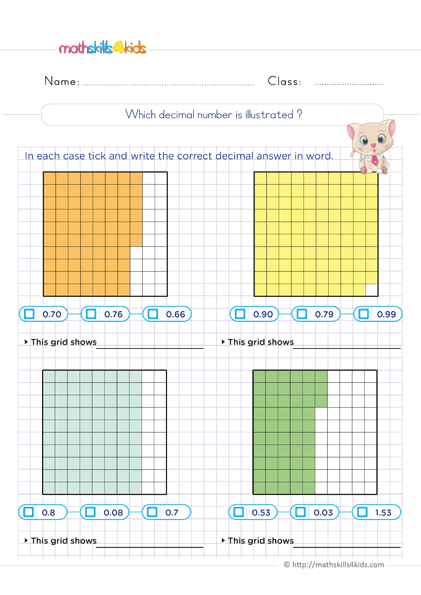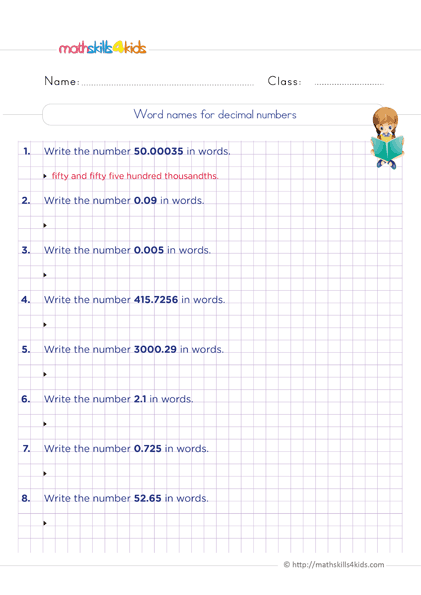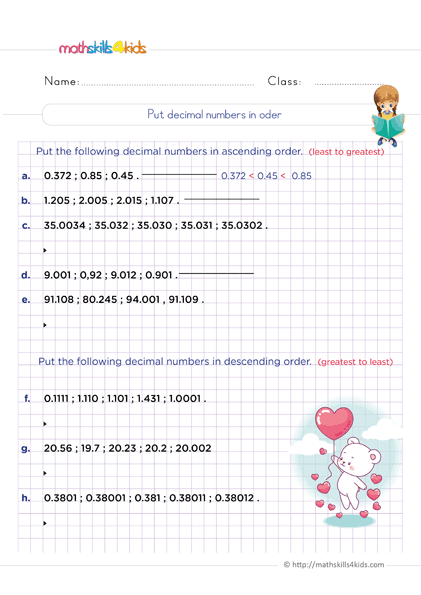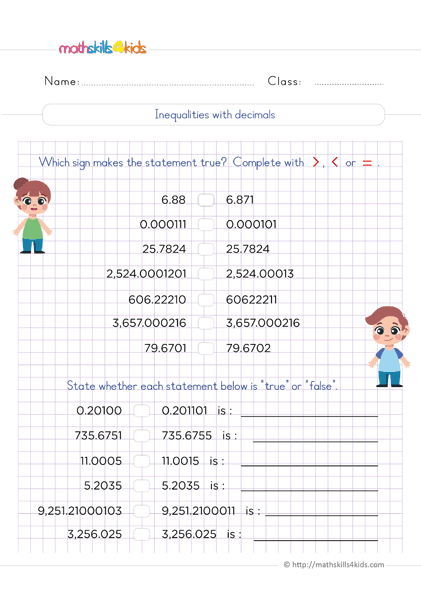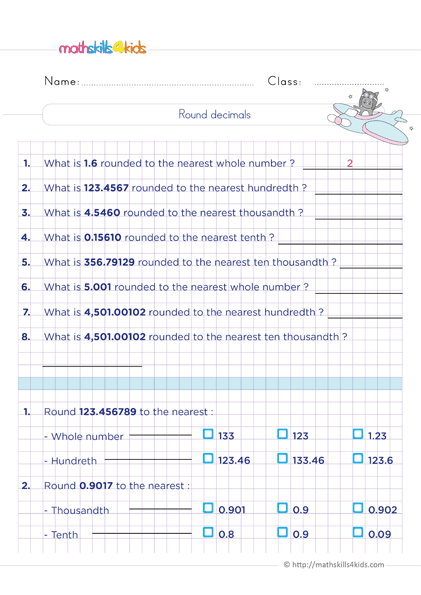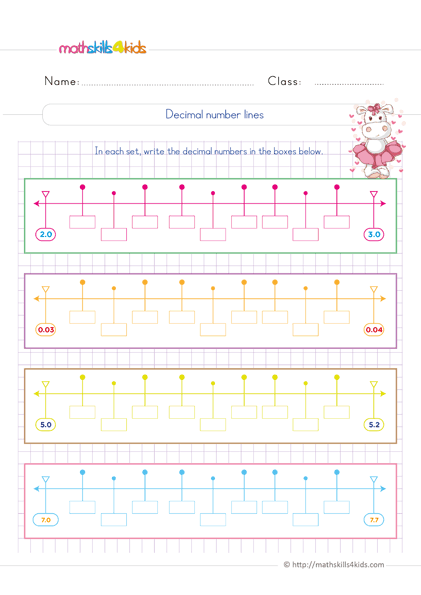Decimals made simple: Worksheets for 6th Grade math lovers
Hi parents and teachers, are you interested in simple worksheets that make decimal learning engaging and fun for your 6th-grade math lovers? If so, you have come to the right place. In this article, you’ll find a vast collection of remarkable Mathskills4kids’ decimals worksheets made simple for your 6th Grade students to quickly master all decimal operations enjoyably.
-
Do you know why decimals are important in math? Do you also know the meaning of decimal digits? Do you know how to read and write decimals in word form, order, round, and compare decimals? This article has answers to all these questions.
In addition, we will provide some examples of real-world applications of decimals. Apart from Mathskills4kids.com, we’ll include additional resources and links for your Grade 6 decimal practice.
6th Grade decimal worksheets: From Basics to Beyond
Do you love math? Do you enjoy working with numbers and solving problems? If so, you might be interested in learning more about decimals. Our collection of 6th Grade decimal worksheets will walk 6th Graders through exploring all decimal operations from basics to beyond classroom learning.
Do you know what decimals are? Decimals are a way of writing fractions using a dot (.) to separate the whole number from the fractional part. Decimals are very important in math because they help us measure things that are not whole, such as lengths, weights, money, time, and more. This article will provide the best worksheets to make decimal practice simple and fun for 6th-grade math lovers.
Let's get started!
-
BROWSE THE WEBSITE
-
DOWNLOAD FREE WORKSHEETS
-
-
GRADE 6 MATH TOPICS
- Whole numbers
- Multiplication
- Division
- Exponents and square roots
- Number theory
- Decimals
- Add & subtract decimals
- Multiply & divide decimals
- Fractions & mixed numbers
- Add & subtract fractions
- Multiply fractions
- Divide fractions
- Integers
- Operations with integers
- Mixed operations
- Rational numbers
- Problems solving
- Ratio & proportions
- Percentages
- Measuring units
- Money math
- Consumer math
- Telling time
- Coordinate graph
- Algebraic expressions
- One step equations
- Solve & graph inequalities
- Two-step equations
- 2D Geometry
- Symmetry & transformation
- 3D Shapes
- Geometry measurement
- Data and Graphs
- Statistics
- Probability
-
Buying is supporting us!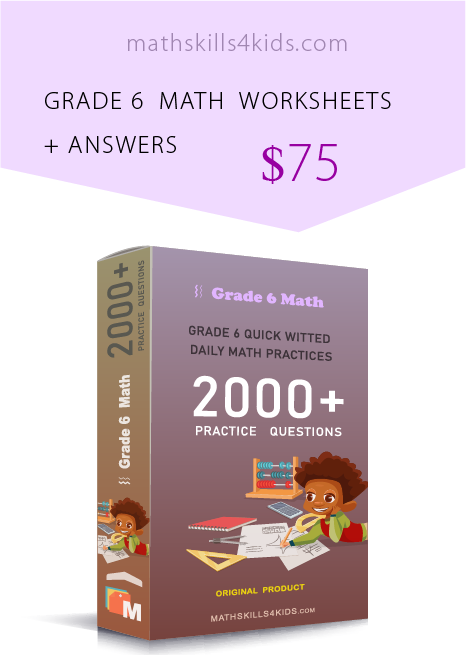
Buy Now...
-
-
Why decimals are important in math
Decimals are important in math for many reasons. First, they help to express numbers that are not whole or exact. For example, the length of a pencil may be more than 15 centimeters and less than 16 centimeters, i.e., somewhere between 15 and 16 centimeters. Here, we can use a decimal to show the precise measurement, such as 15.3 centimeters.
Decimals can also help us compare and order numbers that are not whole. For example, if there are three pieces of cake measuring 0.4, 0.5, and 0.6 kilograms each, we can use decimals to see which piece is the heaviest and lightest.
-
What are decimal digits meaning?
Just like whole numbers, decimals consist of digits. These decimal digits comprise two parts: the whole number part and the fractional part. The whole number part is the number to the left of the decimal point, and the fractional part is the number to the right. For example, in the decimal 12.34, the whole number part is 12, and the fractional part is 34.
The fractional part can be read as a fraction over a power of 10. For example, in the decimal 12.34, the fractional part 34 can be read as 34/100 or thirty-four hundredths.
The digits in the fractional part have different names depending on their position from the decimal point. The first digit after the decimal point is called the tenths place because it represents one-tenth of a whole. The second digit after the decimal point is called the hundredths place because it represents one-hundredth of a whole. The third digit after the decimal point is called the thousandths place because it represents one-thousandth of a whole. And so on.
-
Reading and writing decimals in word forms
Hey 6th Grade math lovers, reading and writing decimals in word forms is a fantastic step towards achieving math success. To read a decimal aloud, students need to say the name of each digit in the fractional part followed by the name of the place value. For example, to read the decimal 12.34 aloud, they’d say "twelve point three four" or "twelve and thirty-four hundredths."
To write a decimal in word form, ask your students to write the word for each digit in the fractional part, followed by a hyphen and the word for the place value. For example, to write the decimal 12.34 in word form, they’ll write "twelve point thirty-four" or "twelve and thirty-four hundredths."
-
Ordering and comparing decimals
To order and compare decimals, 6th graders need to look at each digit from left to right and compare them individually. If two decimals have different digits in the same place value, then the one with the larger digit is greater than the one with the smaller digit. For example;
0.56 is greater than 0.53 because 6 is greater than 3 in the hundredths place. If two decimals have the same digits in the same place value, then compare them to the next place value. For example, 0.56 equals 0.560 because they have the same digits in all places.
-
Rounding decimals
Rounding decimals is a way of making them simpler or more approximate without changing their value too much. To round a decimal to a particular place value, look at the digit to its right and decide whether to keep it or increase it by one. If the digit to its right is less than five, keep it as it is. If the digit to its right is five or more, increase it by one. For example;
To round 0.567 to the nearest hundredth, look at the digit in the thousandths place (7) and see that it is five or more, so increase the digit in the hundredths place (6) by one and get 0.57.
-
Real-world applications of decimals
Decimals are very common in real-life situations where we need to measure or calculate things that are not whole or exact. Some examples of real-world applications of decimals are:
- Measuring lengths, weights, volumes, temperatures, etc.
- Calculating money amounts, discounts, taxes, tips, etc.
- Converting between different units of measurement, such as meters to centimeters, kilograms to grams, etc.
- Representing fractions, percentages, ratios, rates, etc.
Bonus: interactive online resources for decimal practice
If you want to help your 6th graders have some fun and challenge with decimal practice, you can check out these interactive online resources we have selected for you. They are all free and easy to use, and they will help your students practice decimal operations in different ways.
- Khan Academy: This is a great platform for learning and practicing math skills. Kids can watch videos that explain decimals concepts, take quizzes and tests to check their understanding and earn badges and points as they progress. They can also ask questions and get feedback from other learners and teachers. https://www.khanacademy.org/math/arithmetic-home/arith-review-decimals.
- Math Games: This website has a lot of interactive games that your 6th graders can play on a computer or mobile device. They can choose their grade level and the topic they want to practice, such as decimals. They can also customize the difficulty and the time limit of the games. They can play alone or with other players online. https://www.mathgames.com/decimals.
- Math is Fun: This website has many resources that make math fun and easy to learn. Children can read articles that explain decimals concepts, examples, and tips. They can also try exercises and worksheets that test their knowledge and skills. They can also use calculators and tools that help them work with decimals. https://www.mathsisfun.com/decimals.html.
-
-
Thank you for sharing the links of MathSkills4Kids.com with your loved ones. Your choice is greatly appreciated.
Conclusion
Decimals are an essential part of math that students must master to understand more advanced topics. They are also useful in everyday life, as they help us measure, compare and calculate things accurately.
We hope this article has helped you and your students learn more about decimals and how to work with them. We also hope you have enjoyed the worksheets and the online resources we have provided. Remember to visit Mathskills4kids.com for more educational worksheets made simple for your 6th-grade math lovers to practice regularly and have fun with decimals!
